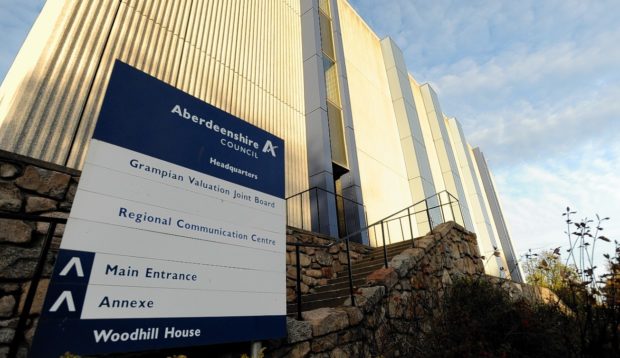Aberdeenshire councillors are poised to swing the axe and cut £28million from the local authority’s budget this year.
The region was already facing an austere 2016 with council spending on education, infrastructure and care expected to be reduced by about £20million.
But after being “shortchanged” by the Scottish Government’s council settlement, councillors have been forced to cut much deeper than first feared.
Now, after protracted backroom wrangling, the SNP-led administration has unveiled a draft budget which includes the necessary cuts and earmarks funding for its priority areas – regeneration, renewable energy and the long-awaited City Region Deal.
Councillors will gather at Aberdeenshire Council’s Woodhill House headquarters to vote on the budget on Thursday.
The final agreement follows a provisional deal with the SNP administration at Holyrood for a reduced settlement of about £430million.
Although Aberdeenshire’s grant was cut by only 1.5% – the least of any authority in Scotland – the funding received by the north-east remains proportionally the third-lowest in the country.
However, local authority chiefs will urge councillors to formally accept Finance Minister John Swinney’s settlement offer, as well as sign-off on the savings proposals which have been laid out.
Councillor Martin Kitts-Hayes, co-leader of the authority, has described the budget as an exercise in improving “efficiency” at the council.
“Our plans are very much on track,” the Inverurie councillor said.
Mr Kitts-Hayes and his fellow co-leader, SNP councillor Richard Thomson, have also rearranged the council’s savings account – putting money into a number of new reserves.
About £5million has been set aside for the City Region Deal – “a key priority” – and another £4million for affordable housing.
A further £5million has been earmarked for regeneration and a renewable energy cash reserve will be formed.
Mr Kitts-Hayes said: “That shows our priorities going forwards.”
He added that the budget would have “the minimum impact on services and staffing”.
“We’re continuing to look at efficiencies across the council, different ways of working, being smarter,” he said.
“Rather than a cut in service, we’ve looked at it as delivering the same service better.”
The co-leader added that he did not expect the usual “theatre” on budget day, because the administration had published its draft in advance and because there was no extra money to spend.
Nevertheless, Mr Kitts-Hayes said he was “open” to innovative ideas from the opposition.
Fellow administration member and leader of the Labour group, councillor Alison Evison, said: “Although we have not faced the same level of budget cuts as elsewhere, we have still had to make some difficult decisions with regard to savings, including in relation to the education budget.
“I am delighted however that within this context the administration has been able to maintain essential and much valued services such as pupil support assistants.”
More than a third of the savings earmarked in the budget will come from a behind-the-scenes shake up of finance and incoming grants.
But in terms of the spending squeeze, the education and infrastructure departments will bear the brunt.
A total of £3.2million will be cut from education, with nearly half coming from reductions in early learning and childcare staffing.
The road maintenance budget will be slashed by £973,000, a reduction of nearly 6%. And £1.4million less will be spent on waste management – including the emptying of waste and recycling bins – than in 2015.
Although the administration will not cut back on the number of teachers in Aberdeenshire – the council is obliged to meet a target and picked up an extra £800,000 of government funding last year for doing so – finance chief Alan Wood said tighter budgets would make further recruitment difficult.
Mr Wood added that, in light of the devastation caused across the region by recent severe weather, councillors must ensure enough money was kept in the authority’s reserves to respond to future storms.
